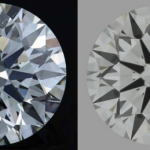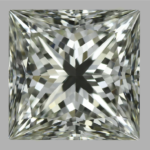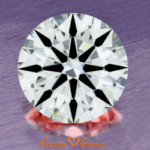White Gold Vs. Platinum – What’s The Difference Besides $$$?
When it comes to buying an engagement ring, most men and women focus all their attention on the diamond(s) and leave little room to think about what metal they are setting their precious jewels in. Your diamond’s setting is very important and has a direct affect on whether it can stand the test of time and everyday abuse that normal wear and tear can cause. Let’s understand the different properties of each of these metals and decide which is ultimately better for your diamond engagement ring.
If White Gold Isn’t Natural – Why Does It Exist?
First of all, there is no such thing as ‘white-gold’. All natural metals are formed in natural shades of whitish-gray with the exception of gold and copper. Metal alloys are created by combining different metals of varying proportions to produce desired color and properties. For example, white gold is simply yellow gold mixed with an alloy (copper, zinc, nickel, silver, palladium) to make it appear white (as well as stronger).
Karat grade in gold will always indicate the amount of gold that is in the alloy. The more natural gold in a white gold alloy, the more “yellowish” it will appear. For example, an 18K white gold ring is only 75% pure gold. The remaining 25% are the alloys that have been mixed with gold to create the white-gray finish. This is the reason why 18K white gold tends to look more yellowish than 14K white gold.
White gold isn’t really white, but rather light-gray (or yellowish depending on the amount of gold in the alloy). It is for this reason that jewelers plate or dip the white gold with rhodium which is a very hard and durable metal. Rhodium is naturally very white, extremely hard, reflective, and virtually tarnish-proof. This rhodium-plating ensures that the white gold reflects a very fine white and shiny surface. Over time and natural wear and tear, this rhodium plating eventually rubs away and will eventually show the yellowish hue of the white gold metal. That is why it is recommended to have your white gold rings rhodium plated every few years to ensure that it looks white and bright.
Many people are drawn to purchase white gold simply because it is a cheaper alternative to platinum. There are four reasons for this:
1) Platinum is extremely rare and difficult to mine
2) Platinum costs roughly 2.5 times as much as gold per gram (due to manufacturing losses/costs from the added expense of processing and refining)
3) Platinum is double the density of gold
4) Platinum used for jewelry is 95% pure vs. 60-75% for 14K or 18K white gold
What About Platinum?
Platinum is a naturally formed white metal that is very closely related to five other metals including: palladium, ruthenium, rhodium, osmium, and iridium. Together, all of these metals share similar chemical and mechanical properties and are known as the platinum group metals. These metals are known for their strength and high durability. Unlike gold, platinum jewelry is 95% pure, with typical alloys of either copper, iridium, palladium, cobalt, ruthenium, tungsten, gallium, or indium making up the additional 5%.
Platinum’s popularity for use in jewelry grew in the late 19th and early 20th century. Its use was abruptly stopped in the 1920’s when it was requisitioned for military use during World War II. It was at this time that white gold was introduced as a substitute for platinum. However, since the 1990’s platinum has once again rose in popularity and is considered a luxury metal for jewelry due to its rarity and purity.
Platinum is considered “better” than white gold for diamond engagement rings because:
1) Its density and weight make it more durable and able to protect your diamond better
2) Due to its chemical make-up, Platinum does not wear away like gold does so it doesn’t get thin or wear away over time
3) Due to its remarkable pliability, Platinum is easier for jewelers to work with for intricate ring design settings
4) Platinum is naturally WHITE and doesn’t require constant rhodium plating to maintain its “white” color and shine
5) Platinum is hypoallergenic (unlike white gold that can produce allergic reactions when alloyed with nickol and other toxic metals)
6) Platinum is 95% pure in diamond engagement settings and feels more “substantial” on the fingers
In some cases, platinum jewelry is rhodium plated as well, but this is just to give it a refined white shiny finish. After some time this rhodium plating is rubbed away, but what remains is a beautiful natural white-gray patina of the natural platinum metal. Continued rhodium plating is NOT necessary.
Interestingly, more than 60% of the world’s platinum consumption goes towards various industries and science. Because platinum exhibits a high degree of electrical, thermo electrical and mechanical stability, with a high level of resistance to heat/corrosion, it makes it virtually irreplaceable to various electronic, precision engineering, the motor industry, and radio/tv manufacturing. It is also used to manufacture surgical instruments within the medical industry.
White Gold Vs. Platinum = Platinum Is Better
In the end, if you are debating on whether to buy white gold vs. platinum it simply boils down to personal taste and ultimately cost considerations. If you are taking the time and putting forth the effort to purchase a quality diamond for your engagement ring, then it just makes sense to spend the extra $$ on a durable, long-lasting, strong metal to hold your precious diamond in.
Hey.You Want Ideal Cut Diamonds?
You've got it.
Join ODBA's Diamond Deal Friday and get handpicked diamonds every week from me to you.
No consultation required. Subscribe now!
ODBA Recommends
You May Also Like









